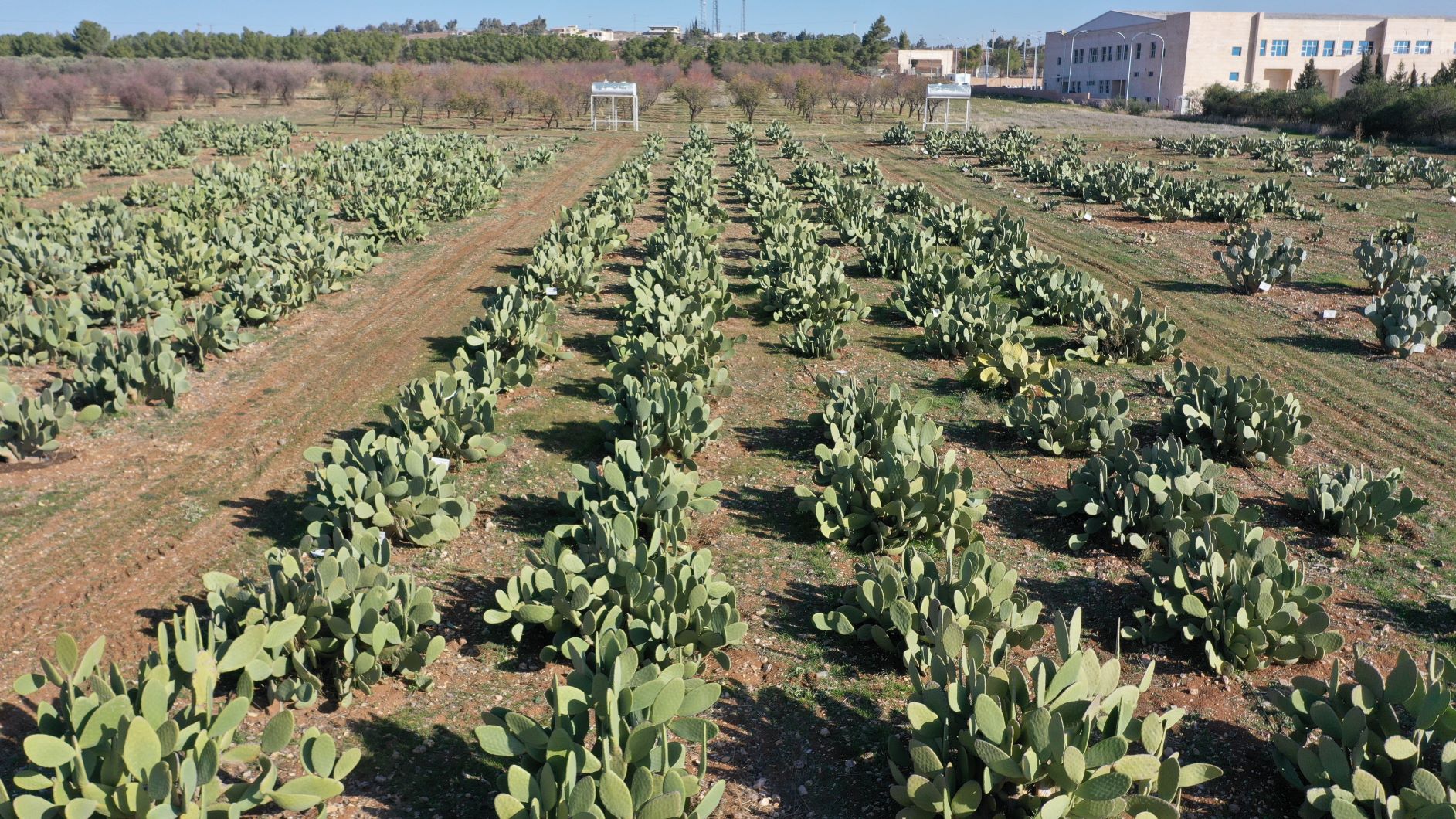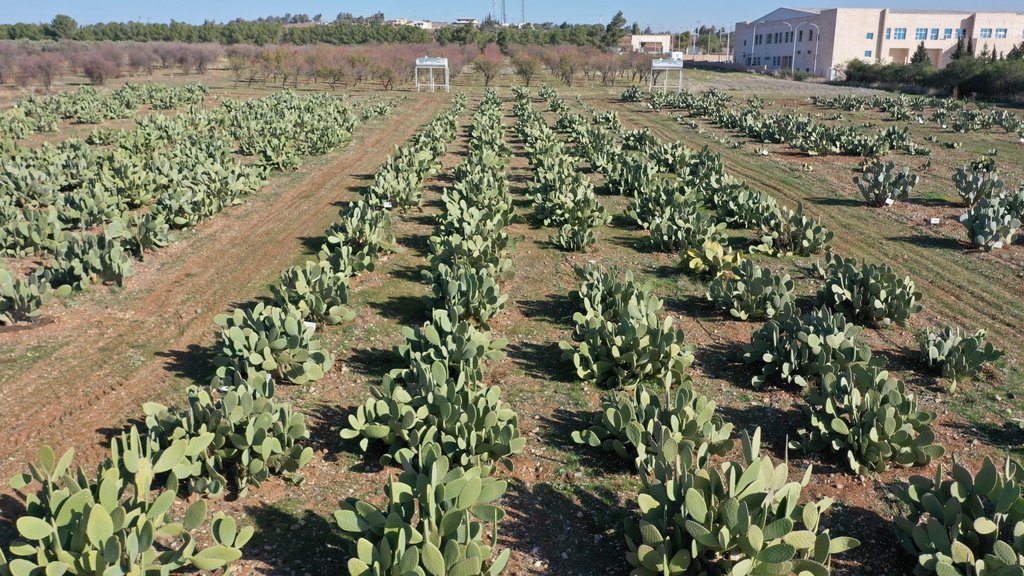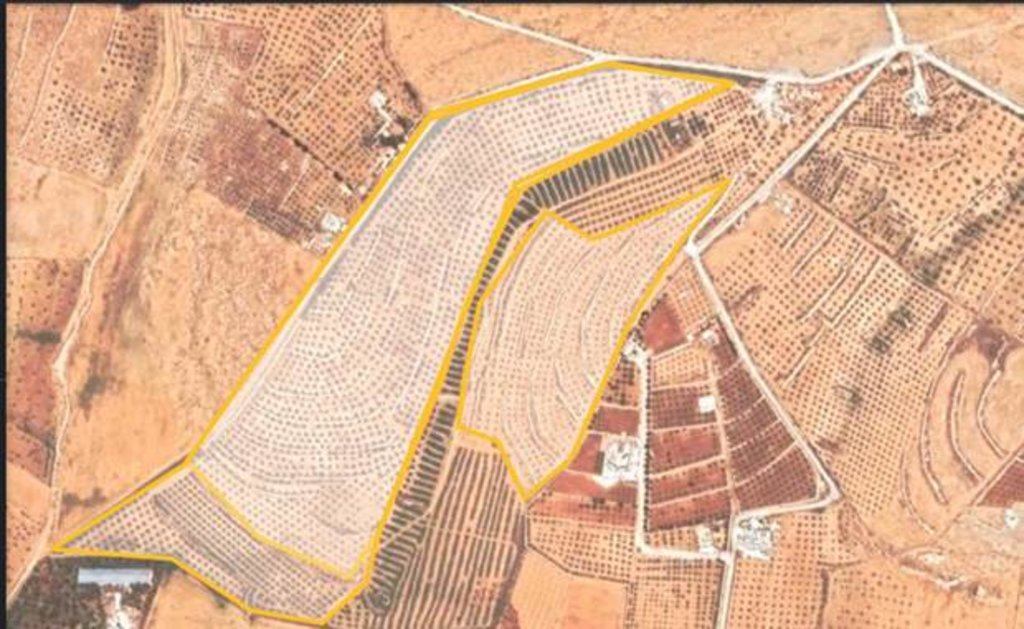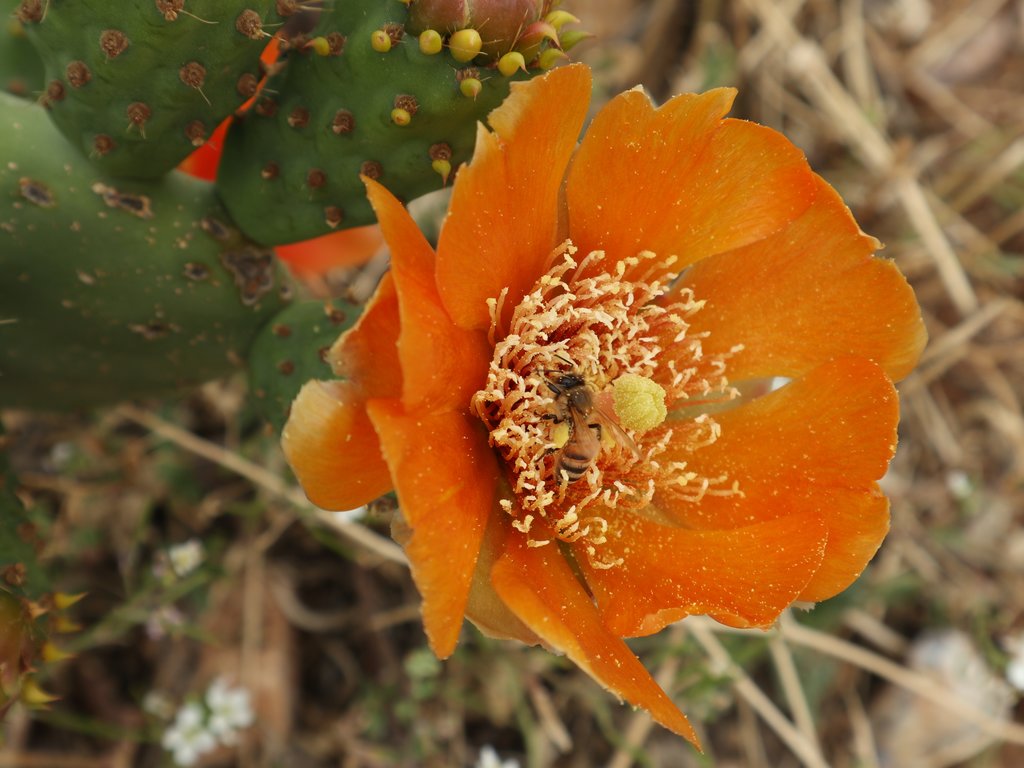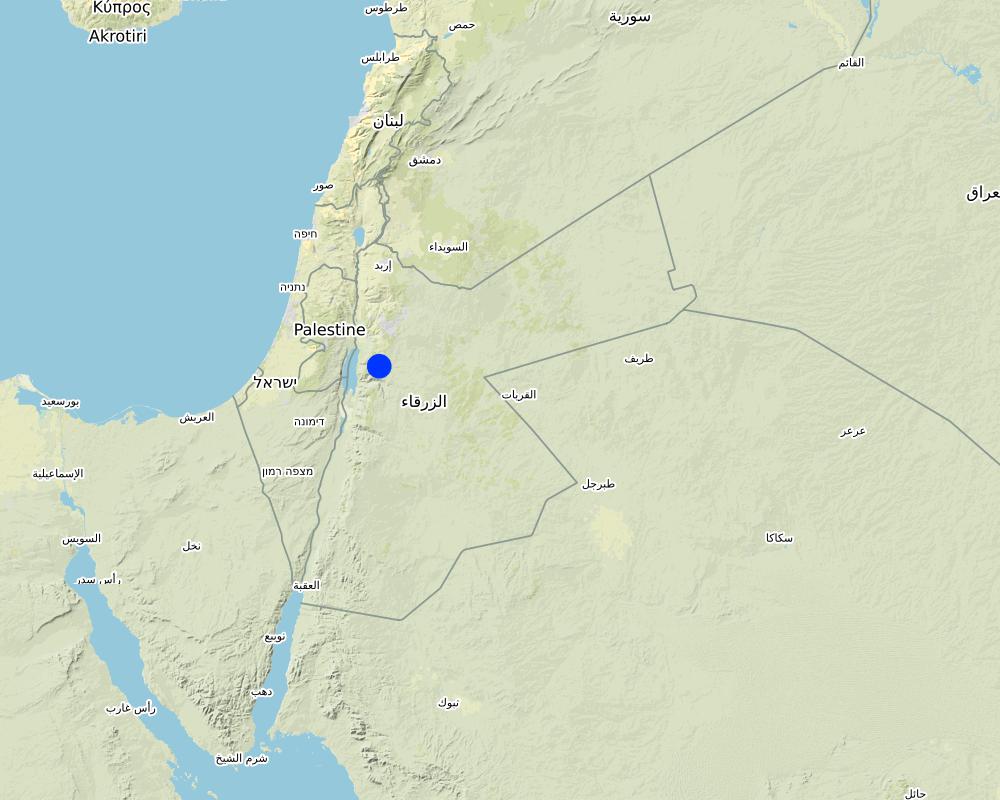Cactus Fruit Plantation in Arid Dry Lands [الأردن]
- تاريخ الإنشاء:
- تحديث:
- جامع المعلومات: Joren Verbist
- المحرر: –
- المُراجع: Rima Mekdaschi Studer
technologies_5847 - الأردن
عرض الأقسام
توسيع الكل طي الكل1. معلومات عامة
1.2 تفاصيل الاتصال بالأشخاص الرئيسيين لمصدر المعلومات والمؤسسات المشاركة في تقييم وتوثيق التقنية
الشخص (الأشخاص) الرئيسي لمصدر المعلومات
Research Team Leader of Rangeland Ecology and Forages:
Louhaichi Mounir
International Center of Agriculture Research in the Dry Areas (ICARDA)
الأردن
Research Associate Coordinator of Forage Systems:
Hassan Sawsan
International Center of Agriculture Research in the Dry Areas (ICARDA)
الأردن
اسم المشروع الذي سهّل توثيق/تقييم التقنية (إذا كان ذلك على صلة)
ICARDA Institutional Knowledge Management Initiativeاسم المؤسسة (المؤسسات) التي سهلت توثيق/تقييم التقنية (إذا كان ذلك على صلة)
International Center for Agricultural Research in the Dry Areas (ICARDA) - لبنان1.3 الشروط المتعلقة باستخدام البيانات الموثقة من خلال WOCAT
يوافق جامع المعلومات والشخص (لاشخاص) الرئيسي لمصدر المعلومات على الشروط المتعلقة باستخدام البيانات الموثقة من خلال WOCAT:
نعم
1.4 إعلان بشأن استدامة التقنية الموصوفة
هل التقنية الموصوفة هنا تمثل مشكلة فيما يتعلق بتدهور الأراضي، بحيث لا يمكن إعلانها تقنية مستدامة لإدارة الأراضي؟:
كلا
2. وصف تقنيةالإدارة المستدامي للأراضي
2.1 وصف مختصر للتقنية
تعريف التقنية:
This technology is based on the natural advantages and the multi-purpose usage of spineless cactus pear (Opuntia fiscus-indica), to cultivate marginal lands in Jordan, generating environmental and socio-economic benefits.
2.2 وصف تفصيلي للتقنية
الوصف:
In the arid parts of Jordan with limited rainfall, little irrigation, high water evaporation, poor soil quality and unsustainable land management result in land degradation (erosion and salinization) and productivity loss. Therefore, the International Center Agricultural Research in the Dry Areas (ICARDA) and National Agricultural Research Centre of Jordan (NARC) organized field days (started in 2014) to disseminate knowledge regarding the cultivation of the cactus pear, Opuntia ficus-indica, cactus crop. Cacti can cope with high temperatures and grow well in (semi)-arid areas with 250-600mm annual rainfall or where irrigation is available. Additionally, the plant is very resilient as it can withstand a long dry season due to its high water-content and water-use -efficiency, which are a result of its morphology (waxy cuticle, no actual leaves) and the Crassulacean Acid Metabolism (CAM). In CAM plant, stomata in the leaves remain shut during the day to reduce evapotranspiration, but open at night to collect and fix carbon dioxide (CO2). In general, cacti have multiple products that benefit local livelihoods, these are for example stable production of fodder for livestock and fruits for human consumption. Also, cactus can grow and produce requiring few inputs such as fertilizers, therefore marginal lands are well suited for cactus cultivation.
The market for cactus fruits is very promising in Jordan. Nowadays, there is high demand for cactus fruits as people grow fond of the fruits but also for medicinal uses. This documentation is focused on a farm covering roughly 10 hectares, where cactus was planted due to its socio-economic and environmental advantages i.e. the high prices for cactus fruits and the ability of cactus to grow in marginal lands with little input and cover the soil hence preventing soil erosion. However, the farm is not located ideally for cactus cultivation. Therefore, the farm is currently intensively managed in terms of fertilizer application and the irrigation. The previous land use was poor cultivation of barley to feed (grazing) sheep and goats. This led to little soil cover resulting in land degradation in the form of erosion. The farmer paid for the establishment of the cactus-plantation. The cacti are spaced by 4 meters between plants and 3 meters between rows. This spacing is specific for fruit production, in case of fodder production a higher crop density is recommended. The cacti are planted on the contours in pits (40 centimetres depth and diameter) to ensure rain-water collection and efficient fertilizer application as the farm is situated on a 15% slope. The cacti reduce erosion as the roots hold the soil together. Field preparation for the establishment of the cactus field includes: (1) soil scrapping; (2) deep soil ploughing; (3) surface soil ploughing; and (4) pit digging. No fertilizer was applied in the establishment stage. Recurrent activities and costs are weeding, applying fertilizer and organic manure, maintaining the pits and harvesting. 200 kilograms per hectare of inorganic fertilizer (NPK) is applied between March and May. A total of 4 tons per hectare of organic manure is applied in September-November. These activities are non-mechanized, and therefore labour intensive.
The farm receives less than 200mm of annual rainfall and a public dam for irrigation is available. Therefore, the farmer invests in three water tanks to store water brought from the dam using his own truck, and in a drip irrigation system for high irrigation efficiency. The farm is irrigated by 360 cubic meter per month, divided in three events. The costs per cubic meter is 0.95 Jordanian Dinar (JOD) (including transportation costs). Before the realization of the drip irrigation system, the cacti were watered by hand (19991-2015). During the initial three years, cacti produce no fruits making the short-term return on investment rather negative. Currently, the cactus-plantation produces 32.5 ton/ha, equivalent to 65 kg /plant. The average net income per hectare varies between 1650 JOD to 2750 JOD. This makes the farmer relatively medium- wealthy with respect to the area. Most costs are induced by labour as the farmer uses manual weeding, harvesting and fertilizer application.
Even though the cultivation of cacti for its fruits on marginal lands has many benefits like the reduction in erosion, stable production, high output/input efficiency and good prices. There are some weaknesses, for example the relative young market of cactus products in Jordan compared to Tunisia. The Tunisian market for cactus products has a longer history, a high demand for other cactus-products like oil and juice and a better infrastructure (e.g. processing units) exist. These create more consistent prices for farmers, so less price drops during harvesting periods. Another weak point is the fact that cacti are cultivated in mono-culture. This significantly increases the risk of new pests and potential damage of the cultivated crop.
To conclude, this documentation shows that even though the selected farm does not represent an ideal site for cactus pear cultivation, the implementation of cacti is socio-economically and environmentally appropriate to cultivate dry marginal lands as cacti uses water and nutrients highly efficient while reducing land degradation. Therefore, the out-scaling of cacti is very valuable and a practical option to fight land degradation and enhance smallholder’s income.
2.3 صور التقنية
2.5 البلد/المنطقة/المواقع التي تم تنفيذ التقنية فيها والتي يغطيها هذا التقييم
البلد:
الأردن
حدد انتشار التقنية:
- منتشرة بالتساوي على مساحة
إذا كانت التقنيةا موزعة بالتساوي على منطقة ما، حدد المساحة المغطاة (بالكيلومتر المربع):
0,09
إذا كانت المساحة الدقيقة غير معروفة، فيرجى الإشارة إلى المنطقة التقريبية المغطاة:
- < 0.1 كم2 (10 هكتار)
هل يقع موقع/مواقع التقنية في منطقة محمية بشكل دائم؟:
كلا
Map
×2.6 تاريخ التنفيذ
اذكر سنة التنفيذ:
2014
2.7 إدخال التقنية
حدد كيف تم إدخال التقنية:
- أثناء التجارب/الأبحاث
- من خلال المشاريع/ التدخلات الخارجية
3. تصنيف تقنية الإدارة المستدامي للأراضي
3.1 الغرض الرئيسي ( الأغراض الرئيسية) للتقنية
- تحسين الإنتاج
- الحد من تدهور الأراضي ومنعه وعكسه
- التكيف مع تغير المناخ/الظواهر المتطرفة وآثارها
- خلق أثر اقتصادي مفيد
- خلق أثر اجتماعي مفيد
3.2 نوع (أنواع) استخدام الأراضي الحالية حيث يتم تطبيق التقنية
استخدامات الأراضي مختلطة ضمن نفس وحدة الأرض:
كلا

الأراضي الزراعية
- زراعة الأشجار والشجيرات
زراعة الأشجار والشجيرات -حدد المحاصيل:
- الصبار،شبيهة الصبار (مثل الصبار الشوكي)
هل يتم ممارسة الزراعة البينية؟:
كلا
هل تتم ممارسة تناوب المحاصيل؟:
كلا
3.3 هل تغير استخدام الأراضي نتيجة لتنفيذ التقنية؟
هل تغير استخدام الأراضي نتيجة لتنفيذ التقنية؟:
- نعم (يرجى ملء الأسئلة أدناه فيما يتعلق باستخدام الأراضي قبل تنفيذ التقنية)
استخدامات الأراضي مختلطة ضمن نفس وحدة الأرض:
نعم
حدد استخدام الأراضي المختلطة (المحاصيل / الرعي / الأشجار):
- الرعي الزراعي (بما في ذلك الإدارة المتكاملة للمحاصيل والثروة الحيوانية)

الأراضي الزراعية
- زراعة سنوية
الزراعة السنوية - حدد المحاصيل:
- الحبوب - الشعير
هل يتم ممارسة الزراعة البينية؟:
كلا
هل تتم ممارسة تناوب المحاصيل؟:
كلا

أراضي الرعي
الرعي الواسع النطاق:
- رعي شبه مرتحل
نوع الحيوان:
- الماعز
- الأغنام
هل يتم تطبيق الإدارة المتكاملة للمحاصيل والثروة الحيوانية؟:
كلا
المنتجات والخدمات:
- اللحوم
- الحليب
3.4 إمدادات المياه
إمدادات المياه للأرض التي يتم تنفيذ التقنية عليها:
- ري كامل
التعليقات:
360m^3 of water applied through drip irrigation. The annual precipitation is less than 200mm
3.5 مجموعةالإدارة المستدامة للأراضي التي تنتمي إليها هذه التقنية
- تحسين الغطاء الأرضي/النباتي
- إدارة الري (بما في ذلك إمدادات المياه والصرف الصحي)
3.6 التدابير التقنية في مجال إلادارة المستدامة للأراضي

التدابير النباتية
- V1: غطاء من الأشجار والشجيرات

التدابير البنيوية
- S7: معدات حصاد المياه/الإمداد/الري

التدابير الإدارية
- M1: التغيير في نوع استخدام الأراضي
3.7 الأنواع الرئيسية من تدهور الأراضي التي تناولتها التقنية

تآكل التربة بالمياه
- الوزن(Wt): فقدان التربة السطحية/تآكل السطح

تآكل التربة الناتج عن الرياح
- (Et): فقدان التربة السطحية

التدهور الكيميائي للتربة
- (Cs): التملح/ القلونة

التدهور المادي أو الفيزيائي للتربة
- (Pk)ظهور وتكون قشرة سطحية

التدهور البيولوجي
- (Bc): تناقص الغطاء النباتي
- (Bq): انخفاض الكمية/الكتلة الحيوية
3.8 منع أو حد أو عكس تدهور الأراضي
تحديد هدف التقنية فيما يتعلق بتدهور الأراضي:
- منع تدهور الأراضي
- الحد من تدهور الأراضي
4. المواصفات الفنية، وأنشطة التنفيذ، والمدخلات، والتكاليف
4.1 الرسم الفني للتقنية
المواصفات الفنية (المتعلقة بالرسم الفني):
The rows are placed 3 meters apart (A), and are located on the contour for rainwater collection as the farm field has a slope of 15% (E). The interspace is 4 meters (D). The cacti are planted in pits that have a diameter of roughly 40 centimeters (C) and a depth of 40 centimeters (B).
المؤلف:
Meike Kleinlugtenbeld & Joren Verbist
التاريخ:
20/12/2020
4.2 معلومات عامة بخصوص حساب المدخلات والتكاليف
حدد كيفية احتساب التكاليف والمدخلات:
- حسب مساحة تنفيذ التقنية
الإشارة إلى حجم ووحدة المساحة:
9.1 hectare
عملة أخرى/ عملة وطنية (حدد):
JOD
إذا كان ذا صلة، وضح سعر الصرف من الدولار الأمريكي إلى العملة المحلية (على سبيل المثال، 1 دولار أمريكي = 79.9 ريال برازيلي): 1 دولار أمريكي =:
0,71
اذكر متوسط تكلفة أجر العمالة المستأجرة في اليوم الواحد:
20
4.3 أنشطة التأسيس
| النشاط | التوقيت (الموسم) | |
|---|---|---|
| 1. | Soil scrapping | Prior to planting |
| 2. | Deep soil ploughing | Prior to planting |
| 3. | Surface soil ploughing | Prior to planting |
| 4. | Pit digging | Prior to planting |
| 5. | Planting cacti | Last third of the dry season (August - October) |
| 6. | Establishment of drip irrigation | If feasible (This case 2015) |
التعليقات:
Drip irrigation can be establishment when feasible (e.g. funds available). It would greatly enhance cactus-production but cacti can survive and produce without it.
4.4 التكاليف والمدخلات اللازمة للتأسيس
| تحديد المدخلات | الوحدة | الكمية | التكاليف لكل وحدة | إجمالي التكاليف لكل مدخل | % من التكاليف التي يتحملها مستخدمو الأراضي | |
|---|---|---|---|---|---|---|
| العمالة | Pit Digging & Planting | Person Hour | 47,0 | 100,0 | 4700,0 | 100,0 |
| العمالة | 100,0 | |||||
| العمالة | 100,0 | |||||
| معدات | Soil Scrapping (Jackhammer) | Machine-Hour | 35,0 | 200,0 | 7000,0 | 100,0 |
| معدات | Deep Soil Ploughing (Tractor) | Machine-Hour | 9,0 | 250,0 | 2250,0 | 100,0 |
| معدات | Surface Soil Ploughing | Machine-Hour | 9,0 | 250,0 | 2250,0 | 100,0 |
| المواد النباتية | Cactus Pads | Pad | 5000,0 | 0,1 | 500,0 | 100,0 |
| مواد البناء | Drip Irrigation (including labour for installation: 14 person days) | Whole System | 1,0 | 13700,0 | 13700,0 | 100,0 |
| مواد البناء | Water Tanks (including labour for construction: 10 person days) | Tank | 3,0 | 500,0 | 1500,0 | 100,0 |
| إجمالي تكاليف إنشاء التقنية | 31900,0 | |||||
| إجمالي تكاليف إنشاء التقنية بالدولار الأمريكي | 44929,58 | |||||
التعليقات:
The cacti are planted in pits. The digging of pits and planting of the cactus pads into the pits is done simultaneously, hence this is grouped in terms of labour. For soil preparation (scrapping and ploughing), the costs of labour are included in the machine costs as this was a hired service. The installation of the irrigation system and the construction of the tanks was each offered as a package and hence include the costs of labour.
4.5 الصيانة/الأنشطة المتكررة
| النشاط | التوقيت/الوتيرة | |
|---|---|---|
| 1. | NPK Fertilizer (1x) | March - May |
| 2. | NPK Fertilizer (1x) | September - November |
| 3. | NPK Fertilizer (1x) | December - February |
| 4. | Organic Manure Application | September - November |
| 5. | Manual Weeding (2x) | March - May |
| 6. | Maintenance of planting pits | April |
| 7. | Harvesting | August - September |
4.6 التكاليف والمدخلات اللازمة للصيانة/للأنشطة المتكررة (سنويًا)
| تحديد المدخلات | الوحدة | الكمية | التكاليف لكل وحدة | إجمالي التكاليف لكل مدخل | % من التكاليف التي يتحملها مستخدمو الأراضي | |
|---|---|---|---|---|---|---|
| العمالة | NPK Fertilizer Application | Person-Day | 9,0 | 20,0 | 180,0 | 100,0 |
| العمالة | Organic Manure Application | Person-Day | 7,0 | 20,0 | 140,0 | 100,0 |
| العمالة | Total Weeding | Person-Day | 200,0 | 15,0 | 3000,0 | 100,0 |
| العمالة | Harvesting / Fruit Grabbing | Person-Day | 280,0 | 20,0 | 5600,0 | 100,0 |
| معدات | Irrigation Management | Person Hour | 252,0 | 100,0 | ||
| الأسمدة والمبيدات الحيوية | NPK Fertilizer | Ton | 2,0 | 1000,0 | 2000,0 | 100,0 |
| الأسمدة والمبيدات الحيوية | Organic Manure | Ton | 40,0 | 30,0 | 1200,0 | 100,0 |
| غير ذلك | Pit Maintenance | Per Pit | 4550,0 | 0,25 | 1137,5 | 100,0 |
| غير ذلك | Water for Irrigation (360m3 per month) | Kubic Metre | 4320,0 | 0,95 | 4104,0 | 100,0 |
| إجمالي تكاليف صيانة التقنية | 17361,5 | |||||
| إجمالي تكاليف صيانة التقنية بالدولار الأمريكي | 24452,82 | |||||
التعليقات:
Irrigation Management consists of filling the tanks and using the drip irrigation.
4.7 أهم العوامل المؤثرة على التكاليف
قدم وصفا لأهم العوامل التي تؤثر على التكاليف:
On the farm most work (e.g. weeding) is done manually. Therefore, the cost of labour contributes significantly to the total cost.
5. البيئة الطبيعية والبشرية
5.1 المناخ
هطول الأمطار السنوي
- < 250 مم
- 251- 500 ملم
- 501 - 750ملم
- 1,000-751 ملم
- 1,500-1,100 ملم
- 2,000-1,500 ملم
- 3,000-2,001 ملم
- 4,000-3,100 ملم
- > 4000 ملم
حدد متوسط هطول الأمطار السنوي (إذا كان معروفًا)، بالملليمتر:
200,00
المنطقة المناخية الزراعية
- شبه قاحلة
- قاحلة
5.2 طوبوغرافيا
متوسط الانحدارات:
- مسطح (0-2%)
- بسيط (3-5%)
- معتدل (6-10%)
- متدحرج (11-15%)
- تلال (16-30%)
- شديدة الانحدار(31-60%)
- فائقة الانحدار (>60%)
التضاريس:
- هضاب/سهول
- أثلام مرتفعة
- المنحدرات الجبلية
- منحدرات التلال
- منحدرات في السفوح
- قاع الوادي
المنطقة الارتفاعية:
- 100-0 متر فوق سطح البحر
- 500-101 متر فوق سطح البحر
- 1,000-501 متر فوق سطح البحر
- 1,500-1,001 متر فوق سطح البحر
- 2,000-1,501 متر فوق سطح البحر
- 2,500-2,100 متر فوق سطح البحر
- 3,000-2,501 متر فوق سطح البحر
- 4,000-3,001 متر فوق سطح البحر
- > 4000 متر فوق سطح البحر
وضح ما إذا كانت التقنية مطبقة على وجه التحديد في:
- غير ذات صلة
5.3 التربة
متوسط عمق التربة:
- ضحل جدًا (0-20 سم)
- ضحلة (21-50 سم)
- متوسطة العمق (51-80 سم)
- عميقة (81-120 سم)
- عميقة جدًا (> 120 سم)
قوام التربة (التربة السطحية):
- متوسط ( طميي، سلتي)
- ناعم/ثقيل (طيني)
قوام التربة (> 20 سم تحت السطح):
- متوسط ( طميي، سلتي)
- ناعم/ثقيل (طيني)
المواد العضوية في التربة السطحية:
- منخفضة (<1%)
5.4 توافر المياه ونوعيتها
منسوب المياه الجوفية:
50-5 م
توافر المياه السطحية:
ضعيف/ غير متوافر
نوعية المياه (غير المعالجة):
مياه الشرب سيئة (تتطلب معالجة)
تشير جودة المياه إلى:
المياه الجوفية والسطحية
هل تعتبر ملوحة الماء مشكلة؟:
نعم
هل تحدث فيضانات في المنطقة؟:
كلا
5.5 التنوع البيولوجي
تنوع الأنواع:
- منخفض
تنوع الموائل:
- منخفض
5.6 خصائص مستخدمي الأراضي الذين يطبقون التقنية
مستقر أو مرتحل:
- غير المترحل
التوجه السوقي لنظام الإنتاج:
- مختلط (كفاف/ تجاري)
الدخل من خارج المزرعة:
- 10-50% من جميع الإيرادات
المستوى النسبي للثروة:
- متوسط
أفراداً أو مجموعات:
- فرد/أسرة معيشية
مستوى المكننة:
- عمل يدوي
- الجر الحيواني
الجنس:
- رجال
عمر مستخدمي الأرضي:
- شباب
- متوسط العمر
5.7 متوسط مساحة الأرض التي يستخدمها مستخدمو الأراضي الذين يطبقون التقنية
- < 0.5 هكتارا
- 0.5 - 1 هكتار
- 1 -2 هكتار
- 2 - 5 هكتار
- 5 - 15 هكتار
- 15 - 50 هكتار
- 50 - 100هكتار
- 500-100 هكتار
- 1,000-500 هكتار
- 10,000-1,000 هكتار
- > 10,000 هكتار
هل يعتبر هذا نطاقًا صغيرًا أو متوسطًا أو واسعا (في إشارة إلى السياق المحلي)؟:
- على نطاق واسع
5.8 ملكية الأراضي، وحقوق استخدام الأراضي، وحقوق استخدام المياه
ملكية الارض:
- لمجموعة
حقوق استخدام الأراضي:
- فردي
حقوق استخدام المياه:
- مجتمعي (منظم)
هل تعتمد حقوق استخدام الأراضي على نظام قانوني تقليدي؟:
نعم
حدد:
Most government land is open access.
التعليقات:
The water comes from a public dam.
5.9 الوصول إلى الخدمات والبنية التحتية
الصحة:
- ضعيف
- معتدل
- جيد
التعليم:
- ضعيف
- معتدل
- جيد
المساعدة التقنية:
- ضعيف
- معتدل
- جيد
العمل (على سبيل المثال خارج المزرعة):
- ضعيف
- معتدل
- جيد
الأسواق:
- ضعيف
- معتدل
- جيد
الطاقة:
- ضعيف
- معتدل
- جيد
الطرق والنقل:
- ضعيف
- معتدل
- جيد
مياه الشرب وخدمات الصرف الصحي:
- ضعيف
- معتدل
- جيد
الخدمات المالية:
- ضعيف
- معتدل
- جيد
6. الآثار والتصريحات الختامية
6.1 الآثار التي أظهرتها التقنية في الموقع
الآثار الاجتماعية والاقتصادية
الإنتاج
إنتاج المحاصيل
جودة المحاصيل
توافر المياه ونوعيتها
الطلب على مياه الري
الدخل والتكاليف
النفقات على المدخلات الزراعية
دخل المزرعة
تنوع مصادر الدخل
الآثار الاجتماعية والثقافية
الأمن الغذائي / الاكتفاء الذاتي
المعرفة بالإدارة المستدامة للأراضي/تدهور الأراضي
الآثار الايكولوجية
التربة
رطوبة التربة
غطاء التربة
فقدان التربة
دورة المغذيات/إعادة الشحن
المادة العضوية في التربة/تحت الطبقة c
التنوع البيولوجي: الغطاء النباتي، الحيوانات
الكتلة الحيوية/ طبقة الكربون فوق التربة
الحد من مخاطر المناخ والكوارث
آثار الجفاف
6.3 تعرض التقنية وحساسيتها لتغير المناخ التدريجي والظواهر المتطرفة/الكوارث المرتبطة بالمناخ (كما يراها مستخدمو الأراضي)
تغير مناخ تدريجي
تغير مناخ تدريجي
| الموسم | زيادة أو نقصان | كيف تتعامل التقنية مع ذلك؟ | |
|---|---|---|---|
| درجة الحرارة السنوية | زيادة | جيدة جدا |
الظواهر المتطرفة / الكوارث المرتبطة بالمناخ
الكوارث الجوية
| كيف تتعامل التقنية مع ذلك؟ | |
|---|---|
| عاصفةبَرَد محلية | ليس جيدا |
| عاصفة ثلجية محلية | ليس جيدا |
الكوارث المناخية
| كيف تتعامل التقنية مع ذلك؟ | |
|---|---|
| موجة حر | جيدة جدا |
| موجة باردة | ليس جيدا |
| ظروف شتاء قاسية | ليس جيدا |
| جفاف | جيدة جدا |
الكوارث البيولوجية
| كيف تتعامل التقنية مع ذلك؟ | |
|---|---|
| أمراض وبائية | ليس جيدا |
التعليقات:
Hail storms and snow storms may occur, but very rarely. An example of an epidemic disease is black spot or rots.
6.4 تحليل التكلفة والعائد
كيف يمكن مقارنة العوائد نسبة لتكاليف الإنشاء (من وجهة نظر مستخدمي الأراضي)؟
عوائد قصيرة الأجل:
سلبي قليلا
عوائد طويلة الأجل:
إيجابي قليلا
كيف تتم مقارنة العوائدمع كلفة الصيانة/التكاليف المتكررة (من وجهة نظر مستخدمي الأراضي)؟
عوائد قصيرة الأجل:
إيجابي قليلا
عوائد طويلة الأجل:
إيجابي قليلا
التعليقات:
The Net Income per hectare varies between 1650 and 2750 JOD.
6.5 اعتماد التقنية
- 1-10%
إذا كان متاحًا، قم بتحديد الكمية (عدد الأسر المعيشية و/أو المساحةالمغطاة):
200 ha
من بين جميع الذين تبنوا التقنية، كم عدد الذين فعلوا ذلك بشكل تلقائي، أي دون تلقي أي حوافز مادية/مدفوعات؟:
- 91-100%
التعليقات:
All farmers who planted cactus started after requiring knowledge about the good prices for cactus fruits and the natural advantages of the cacti. So, this specific technology (Irrigated Cactus plantation) is not necessarily adopted by many farmers. But the use of cacti as a resilient, efficient and profitable crops is however adopted among many other farmers.
6.6 التكيف
هل تم تعديل التقنية مؤخرًا لتتكيف مع الظروف المتغيرة؟:
نعم
إذا كانت الإجابة بنعم، وضح الظروف المتغيرة التي تم تكييفها معها:
- الأسواق المتغيرة
حدد تكيف التقنية(التصميم، المواد/الأنواع، الخ.):
The market demands increase for cactus pears. This results in different crop-spacing because cactus for pear production requires wider spacing, while cactus for fodder production can be planted more dense. Hence, changing market demands for the different products of cactus require different agronomic practices.
6.7 نقاط القوة / المزايا / الفرص التي توفرها التقنية
| نقاط القوة/ المزايا/ الفرص من وجهة نظر مستخدمي الأراضي |
|---|
| The cacti are highly productive with minimum inputs. |
| It does not require much water, which is important as irrigation water availability is a bottleneck for the farmer as well as for most areas in Jordan. |
| The cacti are even productive in poor soil and by growing cacti on these soils, it also reduces erosion. |
| The reduced risk of drought deteriorated yields is important as climate change leads to more extreme weather event, such as droughts. This will only increase in the future. Therefore the cactus's ability to cope with climate change (resilience to climate fluctuations) is a great advantage and increasingly important. |
| نقاط القوة/ المزايا/ الفرص من وجهة نظر جامع المعلومات أو غيره من الاشخاص الرئيسيين لمصدر المعلومات |
|---|
| Due to the suitability of cacti to be cultivated in marginal lands, the soil is partly covered permanently by vegetation in these areas which protects these degraded lands. Therefore, cacti cultivation could offer incentive to prevent land degradation. |
| The technology offers increased resilience of the environment and its involved livelihoods. This is because cacti are more resilient to climate change induced effects such as increased droughts and increasing (summer) temperatures, as result of their high-water content and efficiency. Therefore, this technology is better suited for the future. |
6.8 نقاط ضعف / مساوىء / مخاطر التقنية وسبل التغلب عليها
| نقاط الضعف/ المساوىء/ المخاطر من وجهة نظر مستخدم الأراضي | كيف يمكن التغلب عليها؟ |
|---|---|
| The significant cost related to labour. | According to the farmer there were no alternatives. |
| Marketing can be considered a weakness as during harvest, the supply of cactus fruits was high and thus the selling-prices were low. | By investing in manufacturing/ processing the cacti and stably provide the market with other cactus-products, such as the Tunisian market. |
| The increased risk of new pests. | More awareness is required so the new pests can be identified, allowing proper and timely action. |
| The absence of agro-industrial processing units. Currently, the market demand is mostly related to the cactus fruits. However, cacti offer more such as seeds for oil extraction (such as the Tunisian cactus value chain) . | Investments to enhance cactus-value chain as is done in Tunisia. |
| نقاط الضعف/ المساوىء/ المخاطر من وجهة نظر جامع المعلومات أو غيره من الاشخاص الرئيسيين لمصدر المعلومات | كيف يمكن التغلب عليها؟ |
|---|---|
| The possible knowledge gap for farmers to switch from their conventional/traditional agricultural practices to a more innovative one could be a bottleneck for out-scaling the technology. | This bottleneck can be overcome, by developing social capital such as (e.g.) institutions or farmers networks to disseminate knowledge. A good example is the field days for farmers organized by NARC and ICARDA. |
| The risks of pests and diseases is a weakness of the cacti as these plants are vulnerable to this. Also, due to the density and mono-cropping of the cacti, the pest/ disease may spread easily and rapidly over the field. Eventually, risking the production of the cacti, thus possibly reducing the income of local farmers. | A solution may be found in changing the agricultural activities. An example of such a possible solution is the introduction of intercropping, this could increase bio-diversity and reduce the potential loss of income in case of a pest-outbreak. |
7. المراجع والروابط
7.1 طرق جمع/مصادر المعلومات
- زيارات ميدانية، مسوحات ميدانية
- مقابلات مع مستخدمي الأراضي
- مقابلات مع المتخصصين/الخبراء في الإدارة المستدامة للأراضي
متى تم تجميع البيانات (ميدانيا)؟:
06/12/2020
7.3 روابط للمعلومات ذات الصلة على الإنترنت
العنوان/الوصف:
Fethi Ghouhis, Mounir Louhaichi, Ali Nefzaoui. (12/8/2019). Cactus (Opuntia ficus-indica) utilization for rehabilitating rangelands in arid regions of Tunisia. Acta Horticulturae, 1247, pp. 95-102.
عنوان الرابط URL:
https://hdl.handle.net/20.500.11766/10394
العنوان/الوصف:
Mounir Louhaichi, Sawsan Hassan, Giorgia Liguori. (30/12/2019). Manual: Cactus Pear Agronomic Practices.
عنوان الرابط URL:
https://hdl.handle.net/20.500.11766/10558
العنوان/الوصف:
HO de Waal, Mounir Louhaichi, Makiko Taguchi, Herman Fouché, Maryna de Wit. (25/1/2015). Development of a cactus pear agro-industry for the sub-Sahara Africa Region. Bloemfontein, South Africa: HO de Waal (Curator).
عنوان الرابط URL:
https://hdl.handle.net/20.500.11766/7109
العنوان/الوصف:
Mounir Louhaichi, Sawsan Hassan. (7/10/2018). Managing rangelands: promoting sustainable shrub species: Opuntia ficus-indica (L. ) Mill: a sustainable fodder plant for the dry areas. Beirut, Lebanon: International Center for Agricultural Research in the Dry Areas (ICARDA).
عنوان الرابط URL:
https://hdl.handle.net/20.500.11766/9048
العنوان/الوصف:
Mourad Rekik, Mounir Louhaichi. (9/3/2014). Cactusnet: Promoting the social and ecological benefits of cactus production: Enhancing sheep reproduction through cactus-based feed diets. Beirut, Lebanon: International Center for Agricultural Research in the Dry Areas (ICARDA).
عنوان الرابط URL:
https://hdl.handle.net/20.500.11766/8523
العنوان/الوصف:
Hichem Ben Salem, Mounir Louhaichi. (30/11/2014). Cactusnet: Promoting the social and ecological benefits of cactus production: Promoting Cactus as an alternative and sustainable livestock feed. Beiurt, Lebanon: International Center for Agricultural Research in the Dry Areas (ICARDA)
عنوان الرابط URL:
https://hdl.handle.net/20.500.11766/5454
العنوان/الوصف:
Ali Nefzaoui, Mounir Louhaichi, Hichem Ben Salem. (30/1/2014). Cactus as a Tool to Mitigate Drought and to Combat Desertification. Journal of Arid Land Studies, 24(1), pp. 121-124.
عنوان الرابط URL:
https://hdl.handle.net/20.500.11766/7319
العنوان/الوصف:
Mounir Louhaichi (Producer), Sawsan Hassan (Director). (17/1/2021). Best Agronomic Practices for establishing cactus Orchard. Jordan: International Center for Agricultural Research in the Dry Areas (ICARDA) (Executive Producer).
عنوان الرابط URL:
https://hdl.handle.net/20.500.11766/12374
الروابط والوحدات المواضيعية
توسيع الكل طي الكلالروابط
لا يوجد روابط
الوحدات المواضيعية
لا يوجد وحدات مواضيعية


